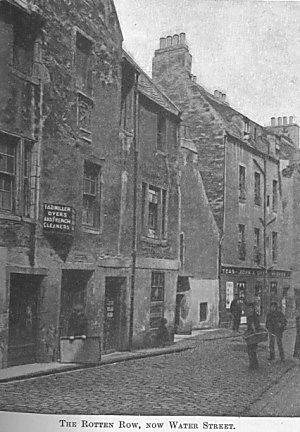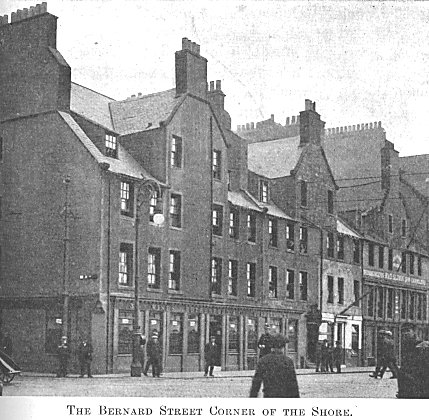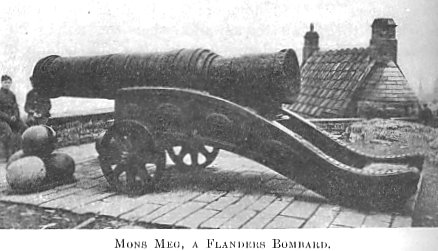This could not but add
greatly to the prosperity and commercial importance of Leith. Yet James
II. does not seem to have had such close association with the Port as his
father had through his foundation and building of the Kingís Wark, his
fondness for pleasure-cruising on the waters of the Firth, and his
interest in shipbuilding and commerce which he did so much to encourage.
Perhaps we might have heard more of the interest of James II. in Leith,
and his connection with it, had the chronicles of his reign not been so
meagre and scanty. Legend, however, sometimes comes to our aid, and we
have a very picturesque one describing Jamesís first recorded visit to
Leith, although he must often have been in the town with his parents and
sisters on their way across the Firth to Perth.
Sir William Crichton, the
Governor of Edinburgh Castle, who, you remember, was one of the
benefactors of St. Anthonyís Hospital, had the queen-mother and the
little king so completely in his power in Edinburgh Castle that they were
virtually prisoners. But Crichton was cleverly outwitted by the queen, who
pretended she was going on a pilgrimage to pray for her sonís health,
and earnestly commended him to his tender care during her absence.
Starting early in the morning she placed her luggage in one chest and the
little king in another, and slung them both from the back of a sumpter
horse. Instead of riding to the shrine of Our Lady at Whitekirk, however,
she galloped to the Kingís Wark on the Shore, and embarking, perhaps in
the kingís barge, perhaps in her own "new little ship," and
sailing under a fair breeze, she was well on her way to Stirling Castle
before Crichton discovered how the queen had proved too clever for him.
In spite of the strife and
disorder that prevailed even in our own neighbourhood between Crichton and
the Forresters of Corstorphine, the trade and commerce of Leith steadily
increased. In 1438, the very first year of Jamesís reign, we get a
glimpse of her growing wool trade with Flanders in the regulations
enjoining all traders sailing outward from the port to give a sack freight
in support of the Scots chaplain at St. Ninianís Chapel in the Carmelite
church at Bruges. Although we have scant record of any association of
James Mm-self with our town, yet he did much to encourage its commerce.
Like his father, King James
granted a charter to the merchant burgesses of Edinburgh, empowering them
to levy certain tolls and dues on the shipping for the upkeep of the
harbour, whose state of disrepair had been the cause of much loss of life.
The Leithers, being "unfree," were again treated as strangers in
their own town, and had to pay the double dues of foreigners. This, of
course, was in strict accordance with the laws and customs of the time,
and, while the Leithers might try to evade the higher charges, they did
not regard them as unjust, for they were equally ready when occasion arose
to prevent strangers from sharing any of the few privileges they
themselves possessed.
There was constant coming
and going of embassies for the promotion of trade between Leith and
Flanders throughout the whole of James II.ís reign. To add Iustre to one
of these, the king sent with it his own sister Mary, when he, no doubt,
came down from Holyrood to the Shore with a company of nobles to see her
off. In her honour splendid receptions were held at Bruges, and the trade
between Leith and that noted seat of commerce was placed on a more
flourishing basis. Another frequent voyager between Leith and Flanders on
business of state, mostly connected with trade, was Alexander Napier, upon
whom for his many services James bestowed the lands of Merchiston, which,
with the old castle of the same name, the family still possess.
Two events of this time
were to place the peoples of Scotland and the Netherlands on a very
friendly footing all through Jamesís reign. The first of these was the
marriage of the kingís sister Mary in 1444 with the Lord of Veere, in
Holland. There is a tradition that the Princess Mary, as we would expect,
encouraged Scots traders to come to Veere. However this may be, Veere some
time after became the chief centre of Leithís commercial intercourse
with the Continent, and continued to hold this position right down to the
period of tile Napoleonic wars.
The second and more
important of the two events that drew into closer alliance the people of
Scotland with those of the Netherlands was the marriage of James II.
himself to Mary, the only daughter and heiress of the wealthy Duke of
Gueldres. Leith was the natural port of arrival for distinguished
foreigners on their way to the Court at Holyrood, and it was to Leith that
this beautiful and accomplished princess came in 1449, the first of
several foreign princesses who landed at the Shore of Leith to become
Scottish queens. Her departure from Holland had been delayed by fear of
attacks from English warships, which were ever ready, even in times of
peace, to waylay ships sailing to and from Scotland. The fleet arrived
safely at Leith, however, where the princess and her brilliant train were
met by the Provost of Edinburgh and a great concourse of citizens as she
stepped ashore at the Kingís Wark.
We can picture to ourselves
the gay and splendid scene on the Shore on that sunny day in June, when
Sir William Crichton, who had been sent to accompany her to Scotland,
introduced the princess to the provost and the gay company of lords and
ladies who had ridden down from Holyrood to meet her. It is difficult for
us in our day, when dress is so simple in form and sober in colour, to
realize the pomp and splendour of a royal progress in medieval times, when
costume was so gay, and so extravagant in fashion, and its costly
materials showed, as they no longer do in our time, the rank and wealth of
their wearers. The arrival of the kingís chosen bride aroused the
greatest interest and enthusiasm. The people crowded the narrow
thoroughfares, that did duty for streets in the Leith of those days, and
the galleries and outside stairs of the quaint, timber-fronted houses,
which were gaily decorated with flowers and tapestry.
 The
princess had a joyous welcome as she rode on horseback, pillionwise,
behind the Lord of Veere in accordance with the custom of the time, for
side-saddles for ladies were unknown in Scotland until Mary Queen of Scots
brought them with her from France. It was with difficulty that the
cavalcade made its way by the Rotten Row and the Kirkgate to St. Anthonyís
Hospital, where Alexander Napier, the kingís treasurer, had arranged for
refreshment before the princess set out for the city. In the Guest-house
of the Blackfriarsí Monastery, whose vaulted gateway stood at the
Cowgate end of the Blackfriarsí Wynd, the princess was warmly welcomed
by the youthful king.
The
princess had a joyous welcome as she rode on horseback, pillionwise,
behind the Lord of Veere in accordance with the custom of the time, for
side-saddles for ladies were unknown in Scotland until Mary Queen of Scots
brought them with her from France. It was with difficulty that the
cavalcade made its way by the Rotten Row and the Kirkgate to St. Anthonyís
Hospital, where Alexander Napier, the kingís treasurer, had arranged for
refreshment before the princess set out for the city. In the Guest-house
of the Blackfriarsí Monastery, whose vaulted gateway stood at the
Cowgate end of the Blackfriarsí Wynd, the princess was warmly welcomed
by the youthful king.
James, like his father, was
keenly interested in artillery, and during his reign "bombards,"
as the great guns of those times were called, were frequent articles of
cargo between Flanders and Leith, where they were stored in the Kingís
Wark or taken to Edinburgh Castle. Among these was the great cannon from
Mons, which, as Mons Meg, is still an object of so much interest and
curiosity to all visitors to the Castle. We can easily imagine the excited
interest Megís arrival on the Shore would arouse among all the people of
the surrounding district, and we may feel certain that, in her progress
towards Edinburgh, she would be accompanied by as large and curious crowds
as Leith showed on the arrival of the first "tank."
His interest in gunnery was
to cost James his life, for he was killed at the siege of Roxburgh Castle
in 1460 by the bursting of one of those bombards in which he used to take
such pride. We may look on Trinity College Church and the Kingís Pillar
in St. Gilesí as tributes of his sorrowing queen to the memory of her
ill-fated husband, whose untimely death plunged Scotland once more into
all the disorder and lawlessness that were wont to prevail when the king
was a child, and which did so much injury to trade and commerce.
During the minority of
James III. the country was undisturbed by foreign invasion, for England
was distracted by the Wars of the Roses, and Scotland was thus left in
peace. That is why trade and commerce still made some progress in spite of
Jamesís weak rule, for he was neither a soldier nor a statesman. As he
grew to manís estate strife and lawlessness continued, for he developed
all the Stuartsí love for favourites, and thus set the nobles against
him. One of his early favourites was Thomas Boyd, a man of great charm of
manner, whom the king had created Earl of Arran, and had married to his
sister Mary. It was this Arran who sailed from Leith on an embassy to the
Court of Denmark to arrange a treaty of marriage between King James and
the saintly Princess Margaret of that country.
 His
embassy was successful in its mission. By the terms of the marriage
treaty, which is still preserved in the Register House, the Orkney and
Shetland Islands came to Scotland as Margaretís dowry, for her father
had no money to spare her. Arran conducted the princess from Denmark to
Leith in July 1469, where her landing rivalled in pomp and splendour that
of Mary of Gueldres some twenty years before. But in the pageantry of this
gala day the brilliant Arran had no share. During his absence his many
enemies had poisoned the mind of the king against him, and his life was
forfeit. Anxiously and in secret, somewhere near the Shore, his devoted
wife, the Princess Mary, awaited his arrival with the Danish fleet in
Leith Roads, and, stealing aboard, warned him of the fate awaiting him. He
had sail immediately hoisted on one of the Danish convoy ships, and,
accompanied by his wife, at once returned to Copenhagen.
His
embassy was successful in its mission. By the terms of the marriage
treaty, which is still preserved in the Register House, the Orkney and
Shetland Islands came to Scotland as Margaretís dowry, for her father
had no money to spare her. Arran conducted the princess from Denmark to
Leith in July 1469, where her landing rivalled in pomp and splendour that
of Mary of Gueldres some twenty years before. But in the pageantry of this
gala day the brilliant Arran had no share. During his absence his many
enemies had poisoned the mind of the king against him, and his life was
forfeit. Anxiously and in secret, somewhere near the Shore, his devoted
wife, the Princess Mary, awaited his arrival with the Danish fleet in
Leith Roads, and, stealing aboard, warned him of the fate awaiting him. He
had sail immediately hoisted on one of the Danish convoy ships, and,
accompanied by his wife, at once returned to Copenhagen.
In the Picture Gallery at Holyrood may be
seen four fine examples of Flemish painting of this period, which
originally formed the altar-piece of the Church of tile Holy Trinity,
built by Mary of Gueldres to commemorate her ill-fated husband, James II.
Two of these paintings show full-length portraits of James III. and his
queen, the Princess Margaret of Denmark, whose reception at the Kingís
Wark amid so many demonstrations of welcome on that far-off July day of
1469 forms one of the many brilliant pageants that have been witnessed by
the Bernard Street corner of the Shoreóa street that in many ways still
has about it much of the spell of ancient days, and seems ever to remind
us of our long and close commercial intercourse with the Netherlands in
centuries gone by. In walking here we might almost believe ourselves to be
on the quayside street of some old Flemish port. And how much more real
must the resemblance have seemed in the days before the formation of the
now extensive docks, when the Shore was the only harbour and its quays
were crowded with great ships, while the sky overhead was chequered with
the picturesque outlines of their masts, yards, and cordage.
Arran was not the only great personage of
Jamesís reign to whom Leith offered a ready means of escape when his
life was forfeit. The king, for reasons we do not fully know, had
imprisoned his brother, the Duke of Albany, in Edinburgh Castle. His
friends, knowing his life to be in danger, endeavoured to effect his
escape. Just at this time a French vessel laden with Gascon wine had
opportunely arrived, and was riding at anchor off the pier of Leith. From
the French vessel they sent him two runlets of wine, which, luckily, were
passed by his guards unexamined and untasted. In one of these was a rope
and a waxen roll enclosing a letter intimating that he was to die ere next
dayís sunset, and urging him to make an immediate endeavour to escape,
when a boat from the French vessel would come ashore for him at Leith.
Albany knew he must either do or die. He
invited his guards to join him in doing honour to the wine, whose
excellence was their undoing, for, when they had become tipsy, they were
slain by Albany. He then escaped to the ramparts overlooking Princes
Street. But in the descent by means of the rope his servant fell and broke
his leg. Albany was unwilling to leave his faithful servant to the tender
mercies of his enemies. Being a man of unusual size and strength, he put
him over his shoulders, and, aided by the darkness, carried him safely to
Leith, where a boat from the French trader awaited them. Daylight revealed
the rope dangling over the Castle rock; but by this time Albany was well
on his way down the Firth to his own Castle of Dunbar, from which
he eventually escaped to France.
James III. became more and
more at odds with his nobles as the years passed. They accused him, among
other misdeeds, of debasing the coinage by mixing brass and lead in the
silver money, and making it pass as fine silver. Like other needy kings,
both before and after him, this he had undoubtedly done. That is why a
pound in Scots money gradually deteriorated in value until it was worth
only a twelfth of our British sovereign. This debasing of the coinage
greatly hampered Leith shipmen and Edinburgh merchants trading abroad, yet
King James III. had no more loyal subjects than the people of these two
towns, and, when the nobles imprisoned him in Edinburgh Castle after the
belling of the cat at Lauder Bridge in 1482, it was the provost and
citizens of Edinburgh who were the chief agents in effecting his freedom.
The grateful monarch, believing, as he said, that "we should bestow
most on those by whom we are most beloved," in return for this and
other services granted to the city the deed known as the "Golden
Charter," an incident depicted in one of the picture panels
decorating the City Chambers.
The Golden Charter
conferred many benefits upon the citizens. We are not concerned with these
further than they affected our town of Leith. This Golden
Charter, whose name is an estimate of how highly it was valued by the
citizens of Edinburgh, conferred upon them the right to levy many new
tolls and dues on the shipping of Leith, with the ownership of the land
along the shore for several miles on both sides of the harbour, and all
the roads leading thereto. As in the charter granted by James I., the dues
chargeable to strangers (foreigners) were to be twice those of freemen.
Now the folk of Leith, being "unfree," had to pay the same
double dues as foreigners in shipping goods into the harbour of their own
town. This was not a decree of the city of Edinburgh. It was a provision
of the kingís charter, and that provision was there because the law of
the land in those days conferred rights and privileges on the freemen of
royal burghs like Edinburgh that it denied to the unfreemen of those
burghs and to dwellers in towns like Leith, which were considered unfree
because they were not numbered among the favoured royal burghs.


